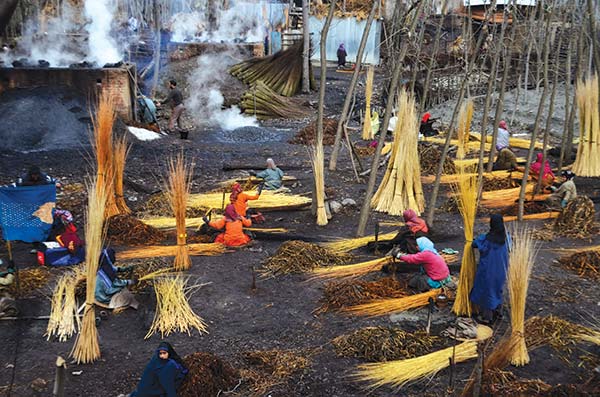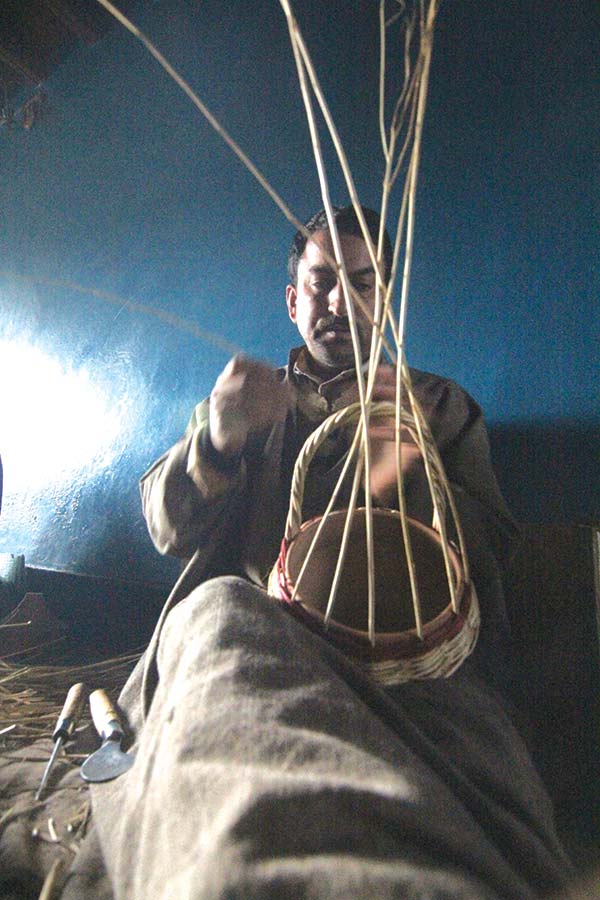For centuries, Kashmir has fought winter with the peculiar firepot, the Kangri. A visit to kangri-makers and understanding the supply demand chain makes Shakir Mir to report that the darling of Kashmir winters is at the receiving end of society’s preference

From crowded Buchpora road, a long narrow lane stretches westward for almost half a kilometre before opening up into a small patch of sunken area, a near-pastoral locality called Umer Heir. In the cold misty mornings of December, girls as young as four swarm jovially and take their positions, almost with the chivalric discipline.
Sitting before their Czapaan – a setup created by tying two parallel sturdy willow stems together, these girls place a meter long heat-soaked, boiled willow twig between the device and pull impulsively, letting the loosened bark part away gracefully.
In a matter of minutes, their hands begin to chafe and their energies flag. Over 20 odd young girls participate in this familial revelry that takes place between November and April perennially, churning out some nine bundles (800 twigs per bundle) of processed twigs daily.
These bundles are no ordinary produce. They are the principal raw material for Kangri-makers across Kashmir. Darling of the winters, Kangri is the traditional earthen firepot encased by an intricate web of interwoven twig artistry. For generations, people here have carried this portable heat-emitting device under the elaborate pheran, the long loose gown. With the onset of winter, the aggressive demand for Kangri’s reinvigorates this cottage industry sustaining as many as 50,000 lives.
The wide dispersal of Kangri users has created scattered spots for its manufacture. Ajas in Bandipore, Seer and Wokie in South Kashmir and Chrar-e-Sharif in Central Kashmir are only a few clusters, which also sell in the city.
Though the basics remain the same, Kangris from different clusters differ in workmanship. The wicker enclosure is made up of at least four different twig varieties but there are instances in which only two types of twigs are used. Pohu Hatab (Parroptiopsis), Krats (Indigofera) and willow shrubs growing in the meadows of Ganderbal, are in wide use.
There is no proper survey but an estimated two million Kangris are manufactured every year. The enormous production is believed to have exerted strain on the regeneration of deciduous shrub growing at the altitude of around 1200 – 2800 meters across Kashmir’s Himalayas.
With cheap electrical appliances flooding the markets before winter, Kangri manufacturers rue, the firepot has suffered a mortal blow.
“A few years ago, I would sell around 1300 kangris a season,” says Mohammad Ashraf Dar, a wicker-worker in Charar. “I just make around 900 now.” Dar confides that the orders are on the decline and more people are giving up the skill and working as labourers in the city.
Located at an elevation of 6350 ft and surrounded by breathtaking upland Karewa’s, Chrar-e-Shareef is the abode of revered Muslim saint Sheikh Noor-ud-Din Reshi. The town is also known for kangris for their idiosyncrasy and heat calibre.
For around 600 families, Kangri manufacture is the mainstay of the economy. “The majority of producers are the part-time farmers,” says Haji Ghulam Rasool, who heads the local Willow Worker’s Association. “Only a dozen-odd families are totally associated with Kangris since the 1960s.”
Chrar alone produces some 50,000 firepots a season. It consumes around 3500 metric tons of twigs annually most of which is harvested from Keller (Shopian) and Lar (Garderbal).
“Our Kangri is has a thin earthen pot which makes it lighter,” Rasool says, his voice quavering from age. “Thin pot ensures more and instant heat even if carries less charcoal.”
A few yards away, Mohammad Shafi works assiduously, trying to plug wickers in and out of a twig frame. His store is a claustrophobic room decorated with different and colourful Kangri’s. A big one dangles outside, beautified enormously with glass shards. “That one is called Shesh Daar,” he says. “It is a bridal Kangir that newly-wed brides take with them.”
Craftsmen purchase twigs at Rs 600 per 5 kgs. They weave seven types of kangris. The basis of distinction is quite uncanny. When the wicker is woven around the earthen pot, it forms the crests and troughs. The crests are the Pohurs or columns. A 12 columned Kangir is the cheapest while 32 columned Kangir is expensive. “Prices vary,” Shafi says. “For example, 12 pohur sells for Rs 100, 24 pohur for Rs 500 and so on.”

While the Chrar Kangris are famous for giving prolonged warmth, those manufactured in the South have remarkable heat-retention capacity. “Our pots are quite strong and doesn’t let the heat taper away easily,” says Abdul Hamid Bhat, a Shaaksaaz from Wokie (Kulgam).
Located at the centre of a sprawling cluster, Wokie is another manufacturing hub. It is fed by weavers from Harigam, Nunpore and Sutch. This cluster might be the main source of Kangris in Kashmir if the market supply chain is tracked. “We are working in this industry for the last 40 years,” Bhat says.
Unlike Chrar produce using four twigs, the Wokie Kangri is made up of just two twigs – Keatch and willow – and yet designed in a way that it doesn’t uncoil or break away easily.
“We keep making Kargris throughout the year,” Bhat says. “But now, it feels like the taste for Kangri’s among Kashmiri’s is diminishing.” Manufacturers like Bhat fear that people have become less willing to shell out money for Kangri’s. “Not all of the produce is sold,” he says. “We have to store it, hoping to put the stock on sale next year.” Bhat foresees shakhsaazs’ slashing the production in coming days for want of demand.
Now a section of the shakhsaazs’ have started diversifying into weaving decorative and household items like baskets, ducks and flowers vases. “That is an export item and fetches more,” Bhat insists.
Interestingly, kangri production is linked to Kashmir’s ecological balance. The main twig, Parroptiopsis shrub, is shrinking. The seed requires passage through the gastrointestinal tract of Black bear and Hangul. “The acids present in their stomach basically dissolves the outer coat or shell of the seed and facilitates its germination,” says Intesar Suhail, a Wildlife Warden.
With the Hangul numbers diminishing, the seed regeneration has taken a hit. Most of the Pohu Hatab cultivators now use budding to regenerate. Its availability has also suffered on account of its increasing use for manufacturing handles for spades, shovels and axes, besides, firewood for the locals.
Modern tools of warmth apart, peculiar Kangri cancer among frequent users is another factor contributing to the fall of its glory. Flagged first in 1973, scientific studies suggest the ulcers that develop because of frequent use of firepot lead to cancers. Endemic to Kashmir, Kangri cancer, a form of skin cancer, once was almost half of total cancer cases but is on the decline now.
In Umer Heir, however, the girls work tirelessly to produce finished twigs. Their chatter is punctuated by the bouts of young laughter. Amidst the woman-only summit, Rouf, 20, thrusts the firewood at regular intervals into the cavity underneath a Bahalar – a cuboidal aluminium cauldron sheathed by bricks and earthen plaster, a boiler. The cavity seethes with leaping flames while a plume of smoke billows out from its partially displaced lid. “We boil the freshly cut twigs for about 24 hours,” he says. “It makes peeling them off easier.”
There are as many as 10 Bahalars in Umer Heir. The girls are paid Rs 35 for every 900-twig bundle. “They do it out of excitement,” says Ghulam Rasool Dar, the patriarch. Almost 80% of households in this neighbourhood are twig processors. They purchase nearly one lakh mann (40 kgs make one mann) equaling 4000 metric tons of unprocessed twigs for Rs 4 lakh. They source it from Tailbal.
Every day in the season, Umer Heir sells 50 manns of processed twigs. “The prices depend on the thinness,” says Rouf. “The thinner the twig, the heavier will be the price.” A Mann sells for anywhere between Rs 1,200 to Rs 3,500.













